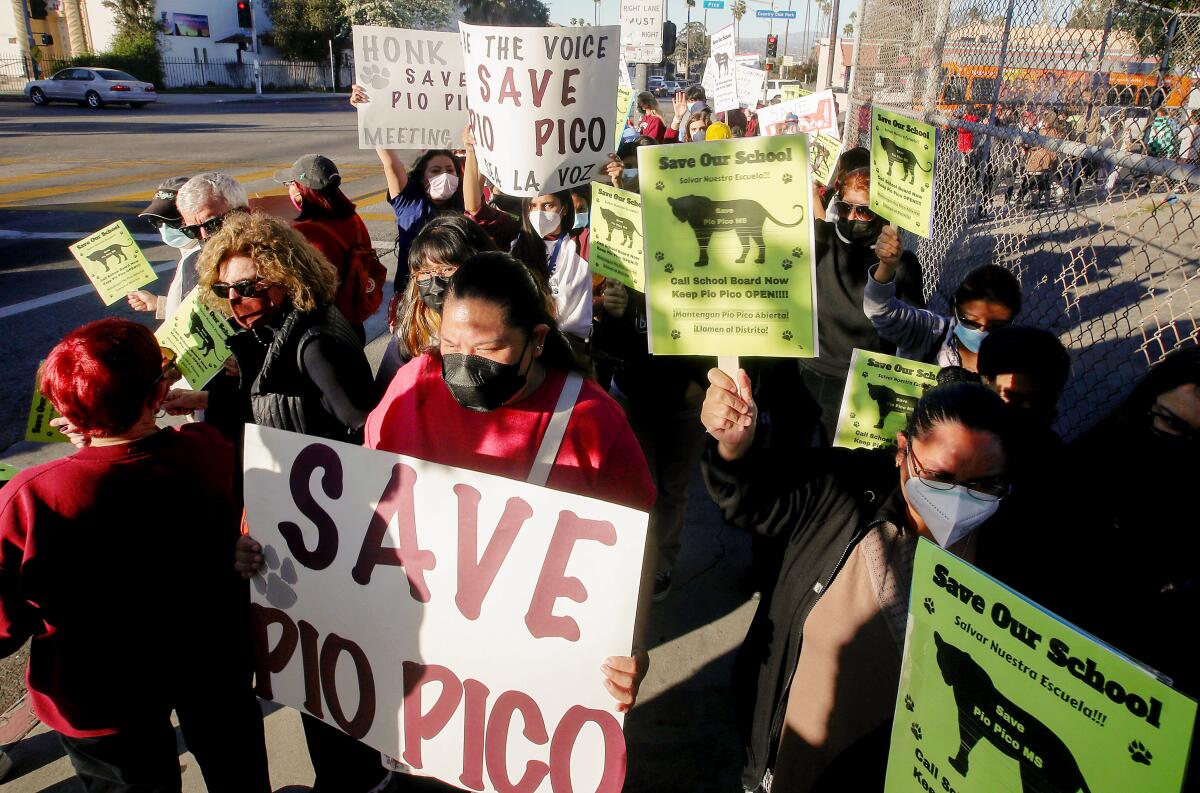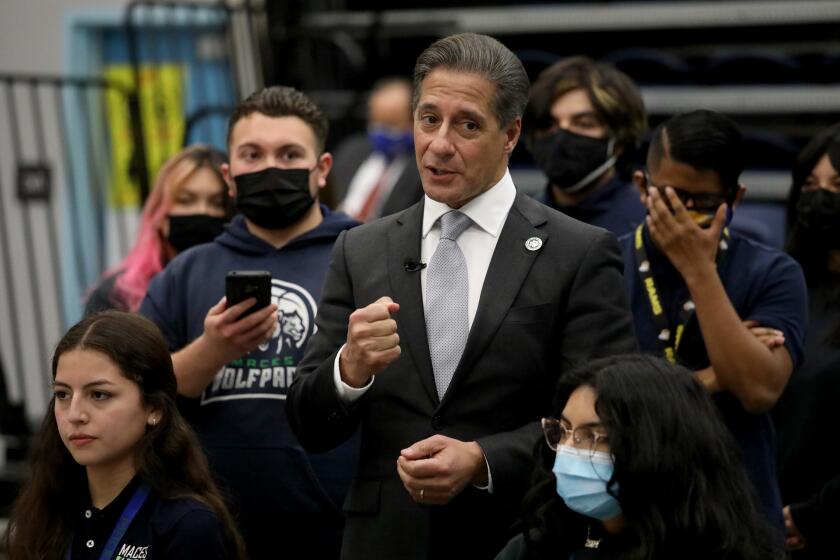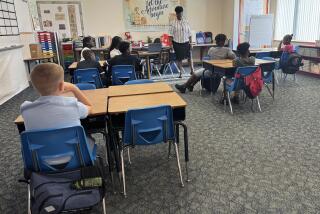Some L.A. schools face uncertain futures as student enrollment declines dramatically

The letter threw Trinity Street Elementary School families into a panic — as much for what it didn’t say as for what it did.
Trinity shares its South Central Los Angeles campus with Gabriella Charter School 2, an elementary program that focuses on dance and the arts. Trinity’s student body is dropping dramatically. Gabriella’s is growing.
“We simply cannot operate a freestanding school at that site with the enrollment we have,” Frances Baez, superintendent of the Los Angeles Unified School District’s central region, wrote to Trinity parents. “Please know that this was a very difficult decision and was not made lightly.”
But the update contained no details. All Baez told the community was that LAUSD would announce a plan sometime in the future.
Nervous parents had questions. Would Trinity close? Where would they send their children? Would they lose their neighborhood school? The letter came in June. Nine months later, there are few answers.
With state funding based on the number of students in the classroom, districts across California are bracing for the effect of declining enrollment — the result of falling birthrates, out-of-state migration, the high cost of living and the growth of charter schools, along with the pandemic.
L.A. Unified did not say how many schools face uncertain futures as a result, but in the last 20 years, the district has seen a 40% drop in the number of students. In addition to Trinity, LAUSD has said it may displace a Westchester magnet school with state-of-the-art engineering stations and allow a privately operated public charter school to take its place. A Mid-City school faces potential closure.
In January, Gov. Gavin Newsom warned that school districts could face “difficult choices.” Already in Oakland, the effect of declining enrollment led officials to approve closing seven schools in coming years.
Trinity, a Latino-majority campus nestled amid tree-lined streets, had more than 1,800 students in 2002. Today, there are 259.
Ingrid Puac, an alumna with two sons at the school, stood outside on a brisk November day alongside other parents, teachers and students protesting a potential closure. “The school,” she said, “belongs to the community.”
Just two decades ago, Los Angeles schools were so overcrowded that students skipped meals and restroom breaks because the lines were so long. With a record enrollment of 747,000 students in 2003, the district could not build schools fast enough, and some sites maintained yearlong schedules, with students attending classes full time over the summer.
But much has changed since then. Today, there are 437,358 students enrolled in L.A. Unified. A district financial forecast, prepared for Tuesday’s school board meeting, estimates that enrollment will dip below 400,000 for the first time in decades in the 2023-24 school year.
L.A. Unified Supt. Alberto Carvalho, when asked about school closures, acknowledged the pandemic’s toll and housing unaffordability that have driven families out of the area. He said the district, although currently flush with federal funding, needed to begin examining enrollment and staffing trends to prepare for potential shortfalls in funding.
“Two years from now, we need to consider the capacity of schools, current enrollment and make decisions in the way we staff schools,” Carvalho told EdSource.
In California, the fertility rate — which is the estimated number of children a woman will have in her lifetime — dropped from 2.2 in 2007 to 1.5 in 2020, hitting the lowest level since the rate has been recorded, according to the Public Policy Institute of California.
In 2005, a two-bedroom apartment rented for about $1,100 in the Los Angeles-Long Beach area, according to the U.S. Department of Housing and Urban Development. Today, it is double that. A household that spends 30% of its income on housing would have to earn $88,000 a year to afford such rent. The median household income in the city of Los Angeles is $67,000.
In addition to demographics and economics, parents and public school advocates have pointed to the rapid growth of charter schools — which have added nearly 90,000 students statewide in the last five years alone — as a factor in declining enrollment.
Pio Pico Middle School, for example, opened in 1987 as a so-called span school, providing an education for elementary and middle-schoolers. At one point, there were more than 1,800 students on campus. Since 2010, five charter schools covering kindergarten through eighth grade have opened less than 2 miles from Pio Pico. Today, the school has about 300 students.
The district plans to shutter the Arlington Heights facility and send Pio Pico’s students to nearby schools. There just aren’t enough staff members to offer anything beyond a bare-bones core schedule there, said Adaina Brown, the local district west superintendent.
What’s planned is an elaborate shuffle of students and schools.
Pio Pico students would be distributed to other campuses, where Brown said the ensuing enrollment bump will allow for expanded classroom offerings.

The Girls Academic Leadership Academy would move into the Pico Boulevard site. GALA, as it’s called, is an all-girls school that focuses on science, technology, engineering and mathematics. Students must apply for admission to GALA, which is operated by the district and is not a charter. The academy opened in 2016 with 160 students; today, there are 700.
GALA shares a campus on West Olympic Boulevard with Los Angeles High School. If it leaves, both schools will have room to grow programs and services, said Cesar Quezada, community of schools administrator for local district west.
“It’s kind of a domino effect in terms of creating more opportunities,” he said.
The school community, however, has sought to change the district’s plans before any school board votes.
On a recent Friday afternoon, Pio Pico students streamed out of class and gathered with teachers and parents. They held signs that read “Save Our School.”
“The school has been amazing to me,” said Jacqueline Cruz, a seventh-grader at Pio Pico who attended the rally. School staff helped her get back into a routine after pandemic lockdowns, and it’s unfair, she said, that she may have to start all over again somewhere else next year.
Her mother, Aletia de Los Angeles, picks her up during her lunch break. The school is near their home, making drop-offs easy.
“It’s just, it’s hard to find something like this at another school,” Jacqueline, 13, said.
At a recent school board meeting, board member George McKenna said decisions about Pio Pico Middle School, which is in his district, were not handled well. But he also said the status quo is not sustainable.
“The fact is, we can’t keep the school open when their enrollment goes so low that it is no longer cost effective, or instructionally effective, or environmentally effective, when there’s another use for it,” he said, “ … and still have a quality educational program, despite the unfortunate consequence of the upheaval of people being moved.”
Jenna Schwartz runs Parents Supporting Teachers, an advocacy group that is generally aligned with the teachers union. She argues that schools are not under-enrolled — they are just not over-capacity as they once were.
“LAUSD should be viewing this situation as an opportunity to give kids extra attention,” Schwartz said. “They missed a year and a half of school. They need extra attention, they need extra time to focus.”
Charter school officials also have pushed back on the notion that they are to blame for LAUSD’s troubles.
“Charter schools shouldn’t be scapegoated by the district,” said Ricardo Soto, chief advocacy officer for the California Charter School Assn. “We certainly recognize the difficulty in making these decisions locally to potentially merge or close down a school facing declining enrollment,” he said, but “there are also some realities about continuing to be able to have small schools operate.”
Brown, the local district west superintendent, said LAUSD schools on the Westside also could benefit from shuffling campuses.
Under a current proposal, Orville Wright Middle — a magnet school specializing in science, technology, engineering, arts and mathematics — and Westchester Enriched Science Magnet High School would consolidate onto the high school’s campus. That would allow WISH Community, a charter school affiliated with the Loyola Marymount University School of Education, to combine its elementary, middle and high schools at the Wright campus.
Currently, Wright Middle and WISH Community share a Westchester campus, which was built in the 1950s but renovated to feature state-of-the-art engineering stations and a community garden.
Wright has 401 students, down from about 670 in the 2016-17 school year. Once the high school campus is upgraded to accommodate Wright’s pupils, Brown said the two schools would be merged to create a span school.
“We’re not necessarily taking a school away from the community, but we want to expand resources and programs to the community by consolidating programs that have been spread so thin due to declining enrollment,” Brown said.
Wright parents aren’t buying it. Lucy Derby, who has a sixth-grader there, said moving the school gives the appearance of putting a charter school over a traditional school’s needs.
“There’s already this feeling of, ‘charter schools are taking away from the neighborhood,’” Derby said. In the district’s proposal, there is no clear benefit to moving the school, she said, and she feels it may actually dissuade parents, including herself, from sending their children there.
As for the Trinity parents in South Central, they hope there’s still time to change school board members’ minds.
Francisco Pastor said he was moved to join the November protest against a potential closure because of his family’s longtime ties to the school.
It’s where his brother went when they were younger. Both of their children attend Trinity. Pastor said his daughter’s teachers have been attentive about keeping her on track during the pandemic, and they have always communicated any issues.
“I would never see myself doing this,” Pastor said, but, “the more people we are, the more they’re going to have to pay attention.”
Baez said in a recent interview that the plan was never to close Trinity, despite what many parents believed.
“I heard their concerns. I’ve been listening,” said Baez, who has said Trinity will remain open during the 2022-23 school year. “There’s a plan in progress that we want to be able to share with the Trinity School community.”
Puac is holding out for written confirmation that Trinity will be saved. Her sons, who are involved in the school’s soccer and running clubs, were upset when the letter announcing the proposed changes arrived.
She wants, she said, “the commitment that they’re going to support our school, they’re going to support our students. We don’t want our students to be evicted out of their school.”
L.A. Unified Supt. Alberto Carvalho announced a 100-day plan, including addressing education recovery and the future of district COVID-19 measures.
More to Read
Sign up for Essential California
The most important California stories and recommendations in your inbox every morning.
You may occasionally receive promotional content from the Los Angeles Times.












